This Alberta county office was completed in 2017. Already it's slated for replacement

A county in northwestern Alberta has decided to replace its structurally unsound administration building just six years after it was built.
Lac Ste. Anne County completed the 27,000-square-foot building in 2017 outside the hamlet of Sangudo, 120 kilometres northwest of Edmonton.
At the time, some residents balked at the project's $11.7-million budget and more than 2,000 people petitioned, unsuccessfully, to stop its construction.
In a May 17 news release, the county said its council made "the difficult but necessary" decision to replace the administration office, which has serious structural problems.
The building has "extensive wall and ceiling cracking," bowing and sloping floor slabs and wall separation, among other problems, the news release said.
"This follows extensive expert investigations and assessments, which unfortunately have concluded that repairing the present damage and maintaining the integrity of the building is not feasible," the release said.
County officials declined an interview for this story.
But in a statement published on its website Wednesday, the county said it hopes construction of a new administration office can be funded with damages from a lawsuit launched in 2019 against "the parties responsible for the situation with the building."
The statement said council and administration "are hopeful for a resolution of the lawsuit in 2024 that would allow for the construction of a new building with funding from the defendants."
More than 11,000 residents live in Lac Ste. Anne County, which includes the towns of Mayerthorpe and Onoway.
Some people who live in the county say the current administration building has been a waste of taxpayers' money.
"We're in an inflation year and now a brand-new building's getting demolished," said Cynthia Smith, who lives on a farm just outside Mayerthorpe.
She said residents wonder where a new building will be located and how much it will cost.

Monaliza Rehn said she has visited the administration building multiple times since moving to Sangudo about two years ago.
"You look up and all of the ceiling and the tall walls are all cracked," she said.
Cracks and clay soil
The administration building was constructed to replace a previous, aging office structure. County council approved the funding in 2015, with roughly 80 per cent coming from grants, according to a news release from the time.
In its May 17 news release, the county said geotechnical experts linked issues to the clay soil the building sits on, and recommended regrading and redirecting surface water.
The county said it made the changes but the building continued to move so it hired structural engineers to investigate.
According to the news release, a team of experts — "including some of the leading structural engineers, geotechnical engineers, architects and construction contractors in the province" — determined that repairing the building "would not be a feasible or reasonable option."
$10-million lawsuit
The county is suing Colliers Project Leaders, A&E Architectural and Engineering Group, Casman Building Solutions, Arrow Engineering and Roterra Piling over the project, seeking $10 million in damages.
In a statement of claim filed in Edmonton Court of King's Bench, the county says it "relied upon the defendants' agreements and representations that they could successfully complete the project, which would include the provision of a new building free from structural and foundation problems."

The county claims it has suffered because of the defendants' "breaches of contract, negligence, acts and omissions."
All of the companies have filed statements of defence denying the county's allegations.
None of the claims have been proven in court.
8 companies involved
The county hired MHPM Project Managers (now Colliers Project Leaders) as project managers. A&E was hired to provide architectural services and Casman was hired as general contractor.
It also hired Barsi Enterprises to do grade preparation work before construction. That company subcontracted J.R. Paine & Associates, an engineering consulting firm, to perform field tests at the site.
In an amended statement of defence filed last month, P. Machibroda Engineering says it was hired by MHPM to provide geotechnical engineering services.
P. Machibroda says in its statement that it advised that the subgrade soils contained "highly plastic clay" and that concrete floor slabs would be subjected to movements associated with seasonal variations.
The company says it provided multiple design alternatives, not recommending one over another.
Colliers, in its statement of defence, denies it engaged P. Machibroda's services. It also says its agreement with the county limited Colliers's liability to $3 million.
In its statement of defence, Arrow Engineering — a subcontractor of A&E — blames the slab heaving on the county's using another subcontractor to "prepare the base on which the slab on grade was placed."
The company also says the county failed to maintain proper drainage around the building, allowing water to enter the soil underneath.
Court documents show A&E has made third-party claims against Arrow Engineering, Barsi Enterprises and J.R. Paine.

In an affidavit filed in January, J.R. Paine president Rick Evans said P. Machibroda was the geotechnical engineer of record for the project.
Evans said J.R. Paine performed tests at the site in 2015. He said the soil containing "high plastic clays with trace organics" was discussed at a 2016 meeting between representatives of J.R. Paine, Lac Ste. Anne County, P. Machibroda and Barsi.
He said J.R. Paine and P. Machibroda representatives talked about the soil risks at the meeting.
"High plastic clay soils onsite have a high shrinkage and swelling potential and as a result may cause poor slab performance," J.R. Paine engineer Scott MacFarlane wrote in an email to Barsi's president a few days later.
Casman, the general contractor, also warned the county about the soil, according to its statement of defence. Casman claims it was directed by the county, designers or others under the county's control to continue with construction.
Roterra Piling, a subcontractor Casman hired to install helical screw piles for the project, said in its statement of defence that the screw piles were a suitable alternative to cast-in-concrete piles, and approved by Arrow Engineering.
CBC News contacted all of the companies involved in the lawsuit. Colliers declined comment, as did Barsi, through a lawyer. The others did not respond.


